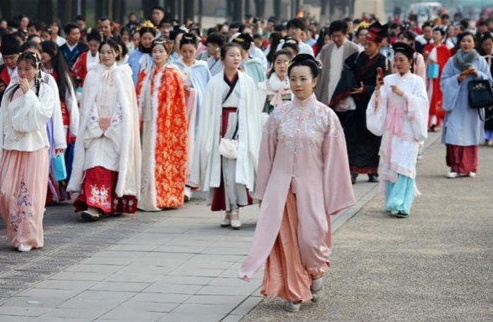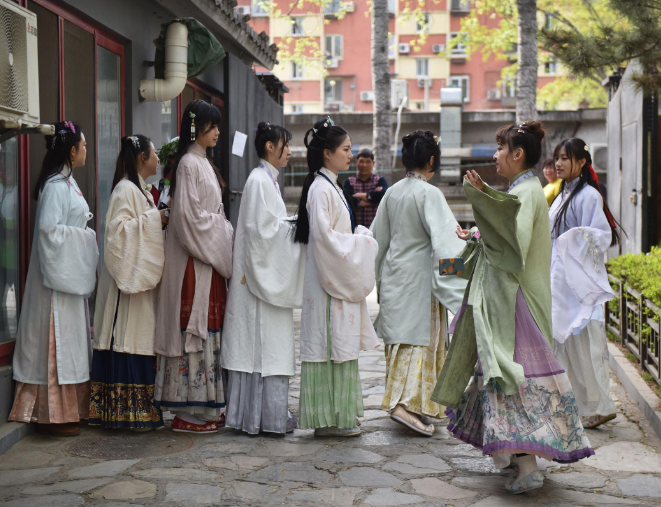Yes, many Chinese people, especially the youth, embrace wearing hanfu as a connection to their heritage.
Historical Significance of Hanfu
The hanfu, a traditional Chinese garment, boasts a rich history that reflects China’s cultural evolution. Initially emerging during the earliest dynasties, hanfu has undergone significant transformations across different eras, each adding unique elements to its design.
The Origin and Evolution of Hanfu
Tracing its roots back to the Huangdi period, the hanfu initially served as a symbol of Chinese identity. The Shang dynasty (c. 1600 – 1046 BC) witnessed the first significant evolution in hanfu design, with silk becoming a predominant material, as evidenced by archaeological findings. During the Zhou dynasty (1046 – 256 BC), the hanfu diversified, incorporating various styles for different occasions and social statuses. This era introduced the ‘yi’, a narrow-cuffed, knee-length tunic tied with a sash, and the ‘shang’, a narrow, ankle-length skirt.
The Han dynasty (206 BC – 220 AD) marked a pivotal point in hanfu’s evolution, where it became more elaborate and symbolic. The introduction of the ‘ru’, a type of blouse, and the ‘ku’, trousers, enhanced both functionality and aesthetic appeal. Emperors of this period often used hanfu’s colors and patterns to denote rank and status, a practice that became deeply entrenched in Chinese culture.
During the Tang dynasty (618 – 907 AD), hanfu reached its peak of elegance and diversity. Influences from the Silk Road introduced new fabrics and styles, leading to vibrant, flowing robes and wide sleeves, as depicted in the paintings and sculptures of the era.

Hanfu in Ancient Chinese Culture
Hanfu was more than a mere clothing item; it was a medium through which the Chinese expressed their values, social norms, and aesthetics. The Confucian ideology, which profoundly influenced Chinese society, was also mirrored in hanfu’s modesty and refinement. The garment was a symbol of the Chinese ethos, emphasizing harmony, balance, and elegance.
In ancient Chinese literature, such as poems and songs, hanfu frequently appears as a motif to convey beauty, emotion, and social status. For instance, in the works of poets like Li Bai and Du Fu, hanfu is often described in detail, highlighting its beauty and the sentiments it evokes.
Throughout its history, hanfu has been a vivid tapestry, intricately woven with the threads of China’s cultural, political, and social evolution. Today, it stands not only as a relic of the past but also as a testament to the enduring nature of Chinese culture. The resurgence of interest in hanfu, fueled by historical dramas and cultural pride, further cements its significance in both past and present Chinese society.
Modern Revival of Hanfu
The modern revival of hanfu represents a fascinating blend of historical appreciation and contemporary fashion. This movement, gaining momentum in the early 21st century, reflects a growing interest in traditional Chinese culture among the younger generations.
The Hanfu Movement in the 21st Century
The hanfu movement initially took root as a form of cultural renaissance among Chinese youth. It started as small gatherings of enthusiasts and quickly evolved into a widespread cultural phenomenon. By embracing hanfu, people found a unique way to connect with their heritage. This movement is not just about fashion; it’s a statement of identity and a means to express pride in Chinese history.
Young designers and cultural activists have been at the forefront of this movement, innovating traditional designs to suit modern tastes. They often blend historical accuracy with contemporary fashion, making hanfu more accessible and appealing to a broader audience. The movement has also spurred interest in traditional Chinese arts and crafts, leading to a revival in related industries.
Influence of Social Media on Hanfu Popularity
Social media has played a pivotal role in the hanfu movement’s explosion in popularity. Platforms like Weibo, Douyin (TikTok), and Instagram have become showcases for hanfu enthusiasts to share their outfits and experiences. Influencers wearing hanfu in beautifully crafted photos or videos have attracted millions of followers, significantly impacting the movement’s reach and appeal.
Online communities dedicated to hanfu have sprung up, offering tips on where to buy outfits, how to wear them, and information on the historical context of different styles. These platforms also host discussions and debates about the significance of hanfu in modern society, further engaging the community.
The hanfu movement’s rise has led to an increase in themed events, such as festivals, parades, and meet-ups, where enthusiasts gather to celebrate their shared interest. These events often blend traditional elements with modern entertainment, creating unique experiences that draw even larger crowds.
The revival of hanfu is a testament to the enduring allure of Chinese cultural heritage. It symbolizes a bridge between the past and the present, allowing a new generation to explore and celebrate their history in a modern context. As this movement continues to grow, it not only enriches the fashion landscape but also deepens the cultural understanding and appreciation within and beyond China.
Hanfu in Contemporary Society
Hanfu in contemporary society represents a unique fusion of tradition and modernity, marking a resurgence of interest in China’s cultural roots. This phenomenon transcends mere fashion, embedding itself in the daily life and identity of many Chinese.
Occasions for Wearing Hanfu Today
Today, hanfu is no longer confined to historical reenactments or cultural performances. It has become increasingly common in various settings, ranging from casual gatherings to formal events. Young people often don hanfu for festivals like the Lunar New Year, Mid-Autumn Festival, and the Dragon Boat Festival, embracing the attire as a way to celebrate their heritage.
Universities across China have started to encourage students to wear hanfu during traditional festivals and cultural events. Some schools even host Hanfu Day, where students and staff celebrate by wearing these traditional garments. This initiative not only promotes cultural awareness but also fosters a sense of community and belonging among participants.
Weddings are another occasion where hanfu has seen a revival. Couples often opt for traditional hanfu ceremonies, blending ancient rituals with modern celebrations. This choice signifies a deep respect for tradition and a desire to root one of life’s most significant moments in cultural heritage.
Public Perception and Acceptance of Hanfu
The public perception of hanfu has shifted dramatically in recent years. Once viewed as a relic of the past, it is now celebrated as a symbol of cultural pride. This change is largely attributed to the efforts of the hanfu movement and the visibility it has gained through social media.
In urban areas, particularly in cities with a strong cultural heritage like Beijing and Xi’an, wearing hanfu in public has become more common. People of all ages can be seen sporting traditional attire in parks, at cultural landmarks, and even in everyday settings like shopping malls and cafes.

The acceptance of hanfu in contemporary society also speaks to a broader trend of cultural revival and interest in traditional values. While it’s a nod to the past, wearing hanfu today is also a statement of individuality and a way to stand out in a globalized world.
In conclusion, hanfu’s role in contemporary society is multifaceted. It serves as a bridge connecting the past with the present, a fashion statement, and a marker of cultural identity. As this trend continues to evolve, it will likely shape and be shaped by the broader dynamics of Chinese culture and society.
Comparison with Other Traditional Attires
The comparison of traditional attires such as hanfu and cheongsam offers a window into the rich tapestry of Chinese cultural history. Each attire carries its unique story, symbolizing different aspects of Chinese heritage.
Hanfu vs. Cheongsam: Understanding Different Cultural Attires
Cheongsam (qipao) and hanfu represent two distinct periods and cultural philosophies in Chinese history. Hanfu, originating from the Han dynasty, reflects the ancient Chinese ethos with its flowing robes and wide sleeves. Cheongsam, on the other hand, emerged during the early 20th century, symbolizing a more modern and cosmopolitan China.
The following table provides a detailed comparison of hanfu and cheongsam across various aspects:
| Feature | Hanfu | Cheongsam (Qipao) |
|---|---|---|
| Origin | Han Dynasty (206 BC – 220 AD) | 1920s Shanghai |
| Fabric | Silk, linen, cotton | Silk, brocade, velvet |
| Design | Loose-fitting, layers, wide sleeves | Body-hugging, high collar, side slits |
| Symbolism | Traditional Chinese values, harmony | Modernity, elegance, femininity |
| Occasions | Festivals, cultural events, daily wear (revival) | Formal events, weddings, modern daily wear |
| Cultural Impact | Represents China’s ancient civilization | Symbolizes the fusion of Eastern and Western fashion |
Influence of Western Fashion on Traditional Chinese Dress
The influence of Western fashion on traditional Chinese dress is most evident in the evolution of the cheongsam. From its origins as a loose-fitting garment, the cheongsam underwent significant transformations in the 1920s and 1930s under Western influence. It adopted a more form-fitting silhouette, reflecting the global trend towards modernity and femininity.
In contrast, the hanfu has seen a resurgence in its traditional form, largely retaining its original design and symbolism. However, modern adaptations sometimes incorporate Western elements in terms of fabric choices and accessories, catering to contemporary fashion sensibilities.
The comparison between hanfu and cheongsam highlights the diversity and evolution of Chinese traditional attires. While hanfu connects to China’s ancient past, cheongsam reflects a period of cultural transition and modernization. Both attires continue to evolve, influenced by global fashion trends while retaining their distinct cultural identities.